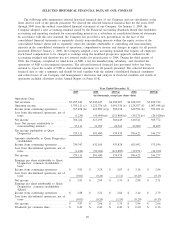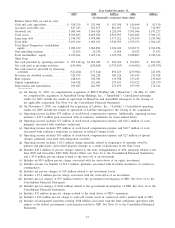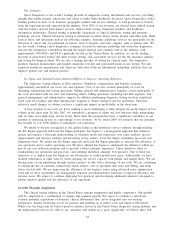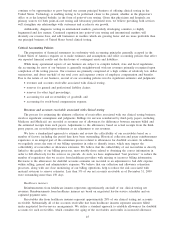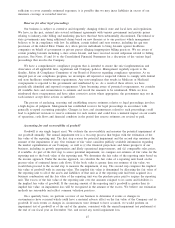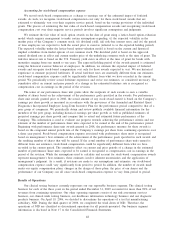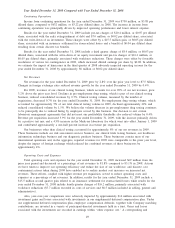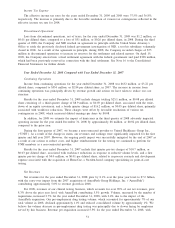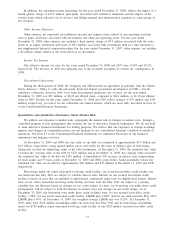Quest Diagnostics 2009 Annual Report Download - page 58
Download and view the complete annual report
Please find page 58 of the 2009 Quest Diagnostics annual report below. You can navigate through the pages in the report by either clicking on the pages listed below, or by using the keyword search tool below to find specific information within the annual report.Accounting for stock-based compensation expense
We record stock-based compensation as a charge to earnings, net of the estimated impact of forfeited
awards. As such, we recognize stock-based compensation cost only for those stock-based awards that are
estimated to ultimately vest over their requisite service period, based on the vesting provisions of the individual
grants. The process of estimating the fair value of stock-based compensation awards and recognizing stock-based
compensation cost over their requisite service periods involves significant assumptions and judgments.
We estimate the fair value of stock option awards on the date of grant using a lattice-based option-valuation
model which requires management to make certain assumptions regarding: (i) the expected volatility in the
market price of the Company’s common stock; (ii) dividend yield; (iii) risk-free interest rates; and (iv) the period
of time employees are expected to hold the award prior to exercise (referred to as the expected holding period).
The expected volatility under the lattice-based option-valuation model is based on the current and historical
implied volatilities from traded options of our common stock. The dividend yield is based on the approved
annual dividend rate in effect and current market price of the underlying common stock at the time of grant. The
risk-free interest rate is based on the U.S. Treasury yield curve in effect at the time of grant for bonds with
maturities ranging from one month to ten years. The expected holding period of the awards granted is estimated
using the historical exercise behavior of employees. In addition, we estimate the expected impact of forfeited
awards and recognize stock-based compensation cost only for those awards expected to vest. We use historical
experience to estimate projected forfeitures. If actual forfeiture rates are materially different from our estimates,
stock-based compensation expense could be significantly different from what we have recorded in the current
period. We periodically review actual forfeiture experience and revise our estimates, as considered necessary. The
cumulative effect on current and prior periods of a change in the estimated forfeiture rate is recognized as
compensation cost in earnings in the period of the revision.
The terms of our performance share unit grants allow the recipients of such awards to earn a variable
number of shares based on the achievement of the performance goals specified in the awards. For performance
share unit awards granted prior to 2008, the actual amount of any stock award earned is based on the Company’s
earnings per share growth as measured in accordance with the provisions of the Amended and Restated Quest
Diagnostics Incorporated Employee Long-Term Incentive Plan for the performance period compared to that of a
peer group of companies. We periodically obtain and review publicly available financial information for the
members of the peer group, including historical earnings per share growth as well as published estimates of
projected earnings per share growth and compare that to actual and estimated future performance of the
Company. This information is used to evaluate our progress towards achieving the performance criteria and our
estimate of the number of performance share units expected to be earned at the end of the performance period.
Beginning with performance share unit awards granted in 2008, the performance measure for these awards is
based on the compound annual growth rate of the Company’s earnings per share from continuing operations over
a three year period. Stock-based compensation expense associated with performance share units is recognized
based on management’s best estimates of the achievement of the performance goals specified in such awards and
the resulting number of shares that will be earned. If the actual number of performance share units earned is
different from our estimates, stock-based compensation could be significantly different from what we have
recorded in the current period. The cumulative effect on current and prior periods of a change in the estimated
number of performance share units expected to be earned is recognized as compensation cost in earnings in the
period of the revision. While the assumptions used to calculate and account for stock-based compensation awards
represent management’s best estimates, these estimates involve inherent uncertainties and the application of
management’s judgment. As a result, if revisions are made to our assumptions and estimates, our stock-based
compensation expense could vary significantly from period to period. In addition, the number of awards made
under our equity compensation plans, changes in the design of those plans, the price of our shares and the
performance of our Company can all cause stock-based compensation expense to vary from period to period.
Results of Operations
Our clinical testing business currently represents our one reportable business segment. The clinical testing
business for each of the three years in the period ended December 31, 2009 accounted for more than 90% of net
revenues from continuing operations. Our other operating segments consist of our risk assessment services
business, our clinical trials testing business, our healthcare information technology business and our diagnostic
products business. On April 19, 2006, we decided to discontinue the operations of a test kit manufacturing
subsidiary, NID. During the third quarter of 2006, we completed the wind down of NID. Therefore, the
operations of NID are classified as discontinued operations for all periods presented. Our business segment
information is disclosed in Note 17 to the Consolidated Financial Statements.
48




